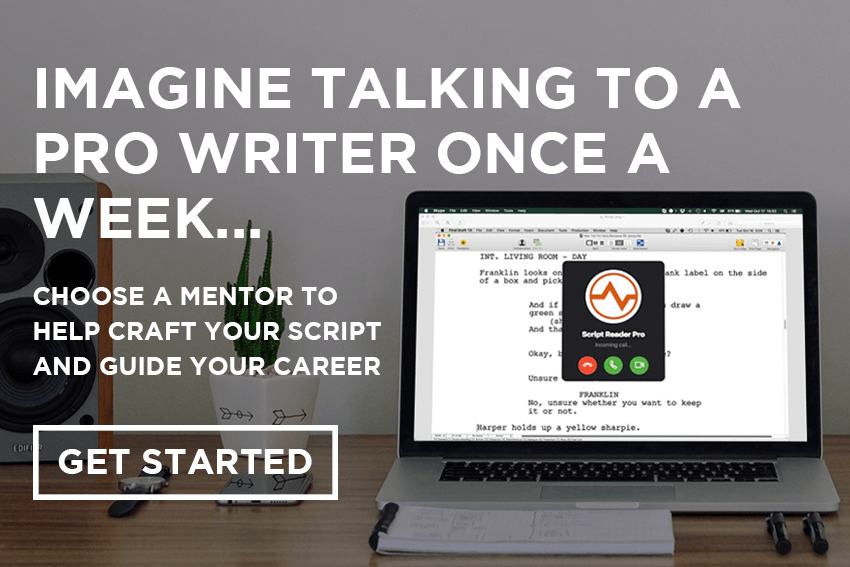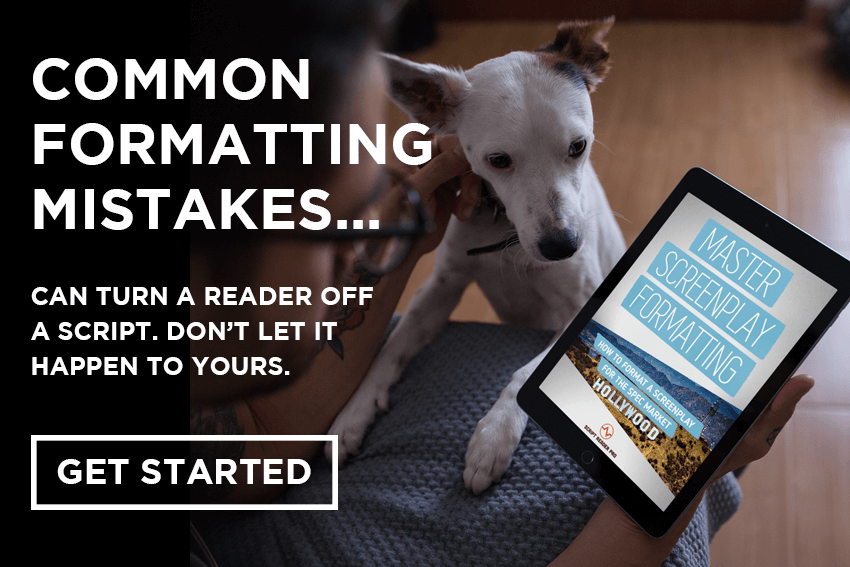
Character description examples: how to hook the reader.
In this post, we’re going to show you how to get the reader to emotionally connect with your characters—particularly your protagonist—by comparing amateur and pro character description examples.
Far too often aspiring writers’ character descriptions involve mundane activities, unrelated to who they’re introducing.
Often this is accompanied by a list of personality traits and/or physical attributes, like so:

These character description examples aren’t bad, but they’re not great either.
But why not?
Take a moment to consider just how much you know about each of these protagonists from their character description examples.
• Do you get a sense of Caitlyn’s personality?
• Do you have any idea what Roger’s fundamental character flaw is?
• Do you get a feeling for who each of these characters are deep down?
Not really.
In fact, it’s probably pretty hard to say you know anything about who these characters really are when we first meet them.
In this post, we’re going to show you the exact steps you need to take in order to go from writing pedestrian character descriptions like these to great character descriptions that immediately hook the reader.
We’re going to do this is by using “before and after” sample character descriptions. So let’s get started.
Amateur vs. pro character description examples.
Here’s a quick character description template of what makes these ones that much better and really hook the reader:
• Interesting Action. The pro character description examples show them in action. It’s just more interesting to be introduced to a character doing something active—preferably something interesting or unusual—rather than something we all do every day.
• Show Don’t Tell. The pro descriptions utilize the “show don’t tell” principle. The writers show the reader who each character is as a person through their actions, rather than simply tell them.
• The Flaw. They show us a moment that perfectly sums up where each character is at in this particular stage in life. These character description examples show us their flaw in action: their “want” rather than “need.” The bad behavior that’s keeping them down at the start of the film.
Overall, you want to show the reader the heart of each character right off the bat when we first meet them.
This usually means showing us their flaw in the most visual, unusual and interesting way possible. (Although not always, but more on this later.)
So let’s jump on in with the first description.
Amateur character description example #1.

Like many character description examples from spec screenplays, this one’s perfectly serviceable.
It puts an image in our mind of a young guy who’s probably single. He’s engaged in an action of sorts—eating a TV dinner—and the car’s arrival adds some interest to the scene.
But you don’t want to write a “serviceable” character description. You want to blow the reader away with the quality of your writing, right?
Professional character description example #1.
Here’s how Dan Gilroy introduces the same character in Nightcrawler:

Ignore the somewhat idiosyncratic formatting for a moment and just focus on how this character description kicks ass.
Focus on how much more you now know and feel about Lou than in the first example.
But how does Gilroy achieve this?
He could have chosen to introduce Lou scouring CraigsList for a job. Or asking a scrap yard manager if he has any vacancies.
While either of these would have told us more about Lou than in Example #1 and made him more active than sitting watching TV, they wouldn’t have been particularly unusual or revealing actions.
Showing him stealing fencing at night, on the other hand, tells us everything we need to know. Our interest is immediately piqued. Who is this weird guy? What’s he doing? Why is he doing it?
Most importantly, Gilroy’s character description shows us Lou’s many flaws in action.
He’s in the middle of a theft and is about to beat up an interfering security guard. He’s “pure primal id” possibly mentally disturbed and insanely driven.
This is the essence of who Lou is at the start of the film and Gilroy captures it all perfectly in this character description.
Here’s another one, this time from a comedy.
Amateur character description example #2.

This character description is clear and succinct and gives us a good idea of what we’re seeing here: two friends having a great time catching up over lunch.
We get the feeling Annie is the protagonist as her name comes first and includes her surname. But what else do we learn about her from this character description?
Not much. We learn nothing about what her personality’s like, where’s she at in life, or what her flaw is.
Professional character description example #2.
Here’s how Annie Mumolo and Kristen Wiig introduce the same protagonist in Bridesmaids.

This is the character description we get after some brief Off-Screen dialogue that sets up the fact this is just a casual fling. (From Ted’s perspective at least.)
This character description is tight and sparse—all we get is Annie’s age. But that’s okay because what she’s doing here is so much more important:
She’s showing us her flaw in action: trying to get together with a guy who has zero romantic interest in her.
One of the key reasons why studio script readers pass on spec screenplays is a lack of empathy for the characters.
This is often because the writer hasn’t fully communicated who the characters really are and what their flaws are right off the bat.
Readers empathize with flaws: the characters (and our) relatable problems that they want to see solved by the movie’s end.
It should be pretty clear that out of these two character description examples it’s Example #4 that better gives you a sense of who Annie is, what her flaw is and where she’s at in this stage of her life.
Amateur character description example #3.
Let’s move on to an example from a recently nominated best-adapted screenplay.

It’s true that Jack’s active here, but how engaging is it? And how much do we learn about him?
We learn that he’s a musician in a hotel room, which could suggest he’s on tour and semi or very successful.
We learn that he likes gin, which could suggest he has a drinking problem, but neither of these is stated explicitly.
Professional character description example #3.
Here’s the same character introduction from A Star Is Born by Eric Roth, Bradley Cooper and Will Fetters.

Now we’re hit in the gut with a character description that shows rather than tells us so much more about him.
Jack is not just involved in an action here that vaguely tells us something about who he is. He’s doing something that shows us explicitly who he is and what his problem is.
He famous enough to draw a large crowd and have roadies. He pops pills before going on stage, drinks deeply from a bottle of gin—some of it “spilling down his beard…”
Note how much more interesting and exciting Example #6 is compared to Example #5. And how it’s now so much clearer that Jack’s a famous musician with a drink and drugs problem. It’s 100 times more engaging, revealing and visual in every possible way.
Character description examples that break “the rules.”
Of course, not all good character descriptions in professional screenplays abide by the “rules” we’ve discussed so far.
• Sometimes in professional screenplays we’re introduced to characters involved in the most mundane activities imaginable.
• Sometimes when writing character descriptions, pro writers don’t give any indication of a flaw.
• Sometimes great character descriptions are so sparse we learn nothing at all about what they look like.
• Sometimes professional screenwriters describe their characters as “handsome” or “a natural beauty.”
Here are a few more character description examples—the ones that seemingly break the “rules” discussed in this post.
Mundane actions in the character description.
Writers Nicole Holofcener and Jeff Whitty introduce the protagonist of Can You Ever Forgive Me? like this:

Here, the writers introduce Lee Isreal in the middle of one of the most everyday situations imaginable: asleep on a couch.
As familiar and uninteresting this situation is, it perfectly sums up where she is at this point in her life: lonely. They even give her a pet cat to really drive the point home.
We don’t know why she’s alone yet but we can guess it’s got something to do with her flaw.
In other words, writing character descriptions doesn’t mean you always have to introduce performing a bizarre or exciting action. It means writing a description that serves the character—whether that’s exciting or mundane.
No flaw in the character description.
In some cases, professional writers choose not to highlight a character’s flaw in their opening character description.
For example, here’s how we first meet Jaime at the start of It Follows:

When writing character descriptions like this, genre comes into play.
The reason why writer David Robert Mitchell doesn’t show us his protagonist acting out their flaw here is that in horror movies they often don’t have one. At least not in a traditional sense.
The theme in horror movies often revolves around the collective “sins” of society rather than an individual flaw of the central character.
The protagonist is a representation of this sin, but because of this, we don’t need to know nearly as much about them as the protagonist in other genres.
Hence we’re not introduced to a protagonist with a flaw in the usual overt way. Rather, the flaw is hidden beneath the surface on a thematic societal level.
No details in the character description.
You may have heard that describing a character’s clothes, hair and makeup is a great way to help give us a sense of who they are as a person. Sometimes professional writers do this, sometimes they don’t.
Occasionally they choose to skip over giving us any specific details at all about a character when we first meet them.
Here’s how Max and Annie are introduced in the Game Night screenplay:

And further down the page:

The writers could have added details about Max’s hair or Annie’s makeup, but they chose not to. All we get are their approximate ages and the fact they’re wearing “matching shirts.”
That’s because it’s the characters’ actions that are important here, not their appearance. We get a sense of who Max and Annie and, in a way, it doesn’t matter whether Max has brown hair or what kind of dress Annie’s wearing.
By all means add clothes, hair and makeup details to your screenplay character descriptions. But remember they’re not as important as showing us those characters in action—usually something that highlights their flaws.
As always when it comes to screenwriting there are very few things you “must not” do. The advice in this post deals with generalities—the best way to introduce most characters most of the time.
At the end of the day, go with what feels right for the character you want to write.
Character description practical exercises.
Here are a number of practical exercises you can do in order to begin writing better screenplay character descriptions.
1. Study great character descriptions.
Take a look at the screenplay character descriptions in these 50 Best Screenplays to Download and Read in Every Genre. Study the first times we’re introduced to any character, not just the protagonist.
Ask yourself questions like:
• Why has the writer chosen to introduce the character this way?
• Why are they doing what they’re doing?
• Are they actively doing something that highlights their current flawed state of mind?
• Or don’t they have an obvious flaw because of the film’s genre?
2. Compare to your own script.
Go through your script and compare your own screenwriting character descriptions. Take a look again at each characters’ introduction, not just the protagonist. Do they stand up to the professional versions?
Ask yourself questions like:
• Who is this character at this specific moment in time?
• What’s their flaw and how do they obviously need to change?
• Are these things clearly shown through actions rather than told through adjectives?
3. Practice writing character descriptions.
Go back into your script and rewrite any mediocre introductions into great character descriptions.
If you’re not clear on the answers to the questions above, go back in and show them acting in a way that clearly communicates the answers to the reader.
Remember in most cases when writing character descriptions it’s a good idea to display their flaw in action.
• First, it’s just more interesting to be introduced to a character doing something active—preferably something unusual—rather than something we all do every day.
• Second, it gives you an opportunity to show not tell. You can show the reader who the character is as a person rather than simply tell them.
Conclusion.
By working through the character description template you’ll learn how to introduce your protagonist in a more powerful way.
Your script overall will subsequently begin in a more powerful way.
Genre and tone will become clearer and the reader will be able to more easily emotionally connect with the protagonist and therefore the story.
In closing, keep in mind Truman peering into a camera in his apartment at the start of The Truman Show.
This seemingly static and unremarkable image actually reveals who he is at the beginning of the film: completely hoodwinked about the circumstances of his own life.
And this is how the writer chose to show us Truman’s essence in a way that’s as visually and thematically as clear and strong as possible.
###
We hope you found these character description examples helpful and feel free to leave any questions you may have in the comments section below. How do you approach writing character descriptions? How seriously do you take each one? Let us know in the comments!
Liked this post? Learn more about writing character descriptions and more writing style hacks…
35 Quick Edits to Improve Your Script’s Writing Style In 24 Hours Or Less
How to Make Your Script Writing Style Leverage 100x More Suspense
Improve Your Screenplay Scene Description in 10 Min With This Method
[© Photo credits: Flickr / Pexels]


















I am writing my first script, based n my published book. The concept is unique but my characters aren’t. This article has given me insight into how poorly I have introduced my characters, particularly the main one(s). Thank you
That’s great to hear, glad it helped, Carol!
I enjoyed this. My characters tend to start out with a Holy C… moment. Before I started this method I though apperance was more important. Not sure what changed my view, but I’m glad I was listening.
Thanks for the comment, Ron – glad you enjoyed it!
On the off chance that you need to understand what a man resembles, investigate how he treats his inferiors, not his equivalents. Have a visit on my blog on The Value of Developing a Fictional Character
I hope this will help.
Thank so much for sharing this information! It’s abig help.
Hey, I’m a passionate screenwriter from Africa, but my question is, what if the antagonists are more than one, do i need to add their characters in detail?
Thank you
It can Derick, but in most cases when the writer is challenged by a mentor to justify two main antagonists the result is blending them back into one. Even Star Wars has one main antagonist with supporting antagonists. All the best.
Do character descriptions follow trends? Meaning is there a difference between today and 10 years ago?
Thank you very much for this great article1 🙂
I am not a screenwriter – but still it’s really helpful!
Great, thanks, Philippe!
Is it overdoing it to create a detailed description for even minor characters? or, generally, just stick to the major characters?
Great question. If minor characters have descriptions that are as detailed as major characters then it’s harder to differentiate the two when we first meet them. You’re kind of telling the reader “this is an important character so look out for them” but then they only serve a drink and aren’t seen again in the script.
Thanks and thanks for a great article.
Thank you for sharing i learn a lot about how to write better character descriptions
Thanks for reaching out 🙂
DL STICKLER
Aspiring screenwriter with an idea, series bible, and pilot in his Google Drive reading some excellent advice on a website he just found while trying to figure out a way to get his work in front of some eyes that may be able to actually send him a check. His sense of cynicism and extreme frugality may prevent him from ever realizing his dream. Yet with gratitude in his heart, he comments sincerely that this post was exceptional in its value to him.
Keep at it, DL!
THANK SO MUCH for your new clear and concise lecture, supported by so many valuable examples and exercises!
Adding a little: Such a description: short, specific, and arresting – three lines for one scene; just a thumb-nail description.
Its content: the age, appearance, clothing, profession, activity, a state of mind etc..
Usually, in the USA, we identify people by their names/nick names and professions/working places.
The core of character is a serious matter. It is point #3 in LINDA SEGER’s (LS) receipt of creating character as follows:
1. Getting the first idea (observation/experience).
2. Creating the first broad strokes.
3. Finding the core of the character (for consistency!).
4. Finding the paradoxes – read: the famous SRP-theory of flaws!
5. Adding emotions, attitudes, and values.
6. Adding details (for the specific and unique character).
Source: LS, “Creating Unforgettable Characters,” Henry Hold & Co., NY 1990, p. 23.
Thanks for this, William – it’ll help our readers even more.
Thanks for the article, admittedly, I struggle with character introduction, but reading this post actually made me realize something, that I oftentimes introduce a character not considering the actual action that is currently taking place. The example you gave for Night Crawler was a real eye opener for me. For example, I had a character that I introduced as: “being both intelligent and powerful, the guy that could out wit you in chess and hand you your ass in the ring”, yet my following action did not show either of these qualities, so I realize that my introduction written like that is just hear-say, which can not be seen, where as the character needs to be visualized and then seen as described.
Thanks for the help.
Thanks for the comment, Rachael – glad the post helped. You’re right – you want to always consider if what you’re describing in the description would be better served by showing us that characteristic in action.
Hi, I am a screenwriter as well and sorry but Greg is right: What is #4 really telling us about the protagonist? That she has passionate sex. Not much else. And shooting directions are supposed to be in shooting scripts. Directors will be turned off pretty quick when finding those in a spec script.
We’re simply saying that many aspiring writers introduce their characters in obvious, uninteresting situations unrelated to their flaw – as in the made-up Example #3. In the actual script, in Example #4, the description is doing much more than just showing Annie have passionate sex. As we say in the post, along with her Off-Screen dialogue with Ted, it reveals her flaw, where she’s at in life and a sense of the problem she needs to solve. It also hooks the reader in a much more interesting way than if we’d just opened on her in a restaurant chatting to Lillian. Do you mean “shooting directions are ‘not’ supposed to be in shooting scripts.”? It’s true you maybe shouldn’t overdo them but there’s no rule out there says you “must never” include shooting directions.
I’m afraid I must take exception to your article. First, are we writing a book or a screenplay? In a book, the writer must be very descriptive. In a screenplay, the writer does not have to be descriptive. So how much detail goes into a script? As much detail is necessary. But, the writer must be careful not to over describe and cross into directorial discretion.
Your example of Bridesmaids is terrible. First, most of the example is action, not character description. Second, use of closeups and jump cuts is directorial, not writing. Leave that to the director to decide how he will shoot the scene. Name me one Shakespeare play where he uses “close up”. Name me one book where they use jump cut. The writer is suppose to write the story. Not direct the film. Eventually, the screenplay will be turned into a shooting script; but, that is after a director is attached.
Third, how much detail do you put in to the script? As much detail is needed. Does it matter if the girl is wearing her hair in a pony tail or just pulled back? If the villain grabs the girl her pony tail as she tries to run away then it is important. But, does it matter if she wears a blue dress or a red dress? No, then it does not go into the screenplay. The director may have a color palette in mind. We recently shot a poster using blue – as in blue sky. So calling for the guy to wear a red shirt would not work for the director.
Now the problem is that most readers can not envision a story without lots of color. They need a book like Crazy Rich Asians or Harry Potter to help them visualize. But, what was written in the book is usually far from what makes it to the screen. A good producer or director can read a script and visual the movie without being encumbered with the writers vision.
Of course, most readers don’t have that vision; otherwise, they would be directing.
We’re a screenplay consultancy not a novel consultancy so the post is most definitely about screenplays. Examples #1, #3, and #5 are made-up character description examples by us from made-up spec screenplays. Examples #2, #4, and #6 are the real character descriptions by professional screenwriters.